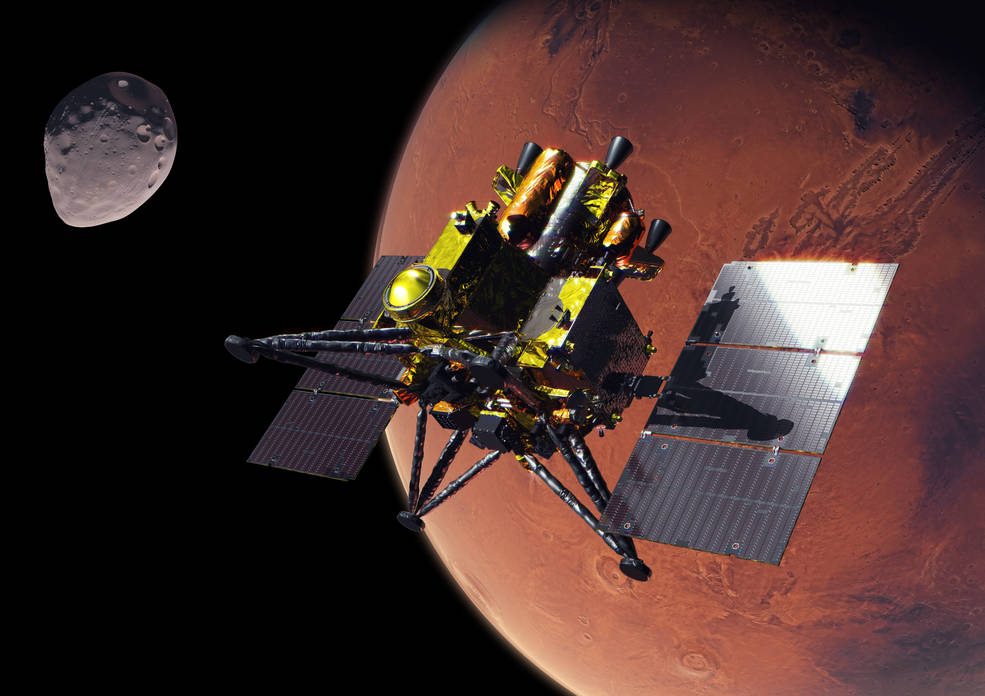Press Release
NASA Taps Two Johns Hopkins APL Scientists for International Mission to Martian Moons
Two researchers from the Johns Hopkins Applied Physics Laboratory (APL) in Laurel, Maryland, are joining the Science Working Team for the Japan Aerospace Exploration Agency’s (JAXA) Martian Moons eXploration (MMX) mission as NASA-supported participating scientists. Scientists Olivier Barnouin and Terik Daly and eight other researchers from institutions across the U.S. will study the two Martian moons, Phobos and Deimos.
With launch planned for 2024, MMX will visit the two moons of Mars, actually landing on and collecting samples from the surface of Phobos. The mission will return the samples to Earth in 2029. The mission aims to understand how Phobos and Deimos formed and how the Martian system evolved.
Seven of the selected scientists will conduct research using the suite of MMX flight instruments.
- Barnouin will create high-resolution digital terrain models of the Martian moons, measuring the properties of surface features and studying the properties of the Phobos regolith through its interaction with the rover.
- Daly will search for surface changes on Phobos and Deimos by comparing MMX image data with past missions’ imagery of the two moons.
- Matteo Crismani (California State University) will study the particles of interplanetary dust that strike Mars and their role in the formation of high-altitude ice clouds in the Martian atmosphere.
- Christopher Edwards (Northern Arizona University) will apply a thermophysical model to MMX infrared spectra to map the variations in spectral properties and surface roughness across Phobos and Deimos.
- Abigail Fraeman (NASA’s Jet Propulsion Laboratory) will combine data from different MMX instruments to learn more about the moons’ compositions and to test hypotheses about the sources of enigmatic spectral absorptions observed on Phobos.
- Sander Goossens (NASA’s Goddard Space Flight Center) will use data from the MMX instruments and navigation data from the spacecraft to constrain the moons’ gravity fields, shapes, rotational states and internal mass distributions.
- Christine Hartzell (University of Maryland) will explore the physical properties of Phobos’ surface regolith by using rover data to identify regolith clumps and constrain the forces needed to hold them together.
Three of the selected scientists will conduct laboratory analyses of the samples brought back from Phobos.
- Nicolas Dauphas (University of Chicago) will use mass spectrometer techniques to determine elemental and isotopic abundances of iron, potassium and other elements, and to measure ages using rubidium-strontium dating.
- Jemma Davidson (Arizona State University) will use microscopy and mass spectrometry methods to analyze opaque minerals in the Phobos samples, to elucidate the origin of Phobos and its later alteration history.
- Daniel Glavin (NASA’s Goddard Space Flight Center) will study amino acids, cyanides, amines, aldehydes, ketones, and hydroxy and monocarboxylic acids using gas and liquid chromatography mass spectrometry.
Barnouin said the proposed work leverages APL’s experience with a variety of asteroid missions, such as the Near Earth Asteroid Rendezvous (NEAR), Hayabusa and Hayabusa2, OSIRIS-REx and, most recently, the Double Asteroid Redirection Test (DART).
“We’ll model the topography of Phobos and Deimos with a team of international partners from Japan and Europe that are all part of MMX to identify a safe landing site for sampling and roving,” he said. “This collaborative research effort will help us understand the origin and evolution of these Martian moons.”
In addition to the contributions of the participating scientists and their teams of co-investigators, NASA is contributing to the Mars-moon Exploration with GAmma rays and NEutrons (MEGANE) spectrograph instrument, the Pneumatic Sampler (P-Sampler) technology demonstration and other support.
MEGANE (pronounced meh-gah-nay, meaning “eyeglasses” in Japanese) was developed by a team led by SES’ David Lawrence, the instrument’s principal investigator. By measuring the energies of neutrons and gamma rays emitted from the small moon, MEGANE will give MMX the ability to “see” the elemental composition of Phobos.
APL is also providing use of its Small Body Mapping Tool, which will enable 3D geospatial analyses of data taken by MEGANE and by some of the cameras on MMX. The tool provides a streamlined way to search, access and analyze spacecraft data of small bodies — particularly irregular asteroids, moons and comets — in 3D.
“The Small Body Mapping Tool played an integral role in the analysis of data during the OSIRIS-REx and DART missions, and I’m excited to see how the tool will accelerate science analysis and data fusion for the MMX mission,” Daly said.
A NASA-sponsored team at Honeybee Robotics designed and built the P-Sampler. The APL-built MEGANE was developed under NASA’s Discovery Program. Both projects are managed by NASA’s Marshall Space Flight Center in Huntsville, Alabama, for the agency’s Science Mission Directorate.
In a separate event on April 17, during the 38th Space Symposium in Colorado Springs, Colorado, NASA and JAXA signed an agreement to formalize their MMX cooperation, further strengthening the collaboration between the two agencies.
